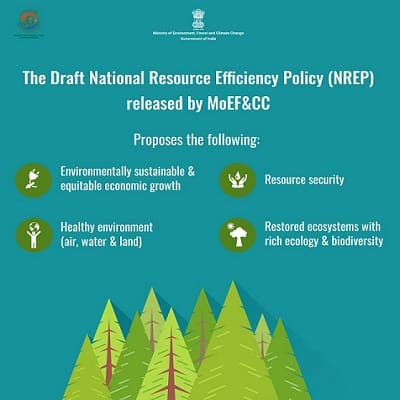The Union Ministry of Environment, Forest and Climate Change (MoEFCC) released a draft on National Resource Efficiency Policy (NREP) 2019. It aims to streamline the efficient use of the resources with minimum negative impact on environment.
Vision
NREP envisions a future with environmentally sustainable and equitable economic growth, resource security, healthy environment (air, water and land), and restored ecosystems with rich ecology and biodiversity.
Principles
The guiding principles of the policy are:
- Reduction in primary resource consumption to ‘sustainable’ levels, in keeping with achieving the Sustainable Development Goals (SDGs) and staying within the planetary boundaries.
- Creation of higher value with less material through resource efficient and circular approaches.
- Waste minimization.
- Material security.
- Creation of employment opportunities and business models beneficial to the cause of environment protection and restoration.
Scope
- NREP encompasses resources and materials used across all life cycle stages of any sector. The resources & materials are Water, Land and Soil, Air, Fossil fuels, Non-metallic Minerals, Metals and Biomass.
- Life cycle of any product covers all stages including raw material extraction, material processing, production, use and maintenance, disposal and end-of-life management.
National Resource Efficiency Authority (NREA)
National Resource Efficiency Authority (NREA) will be constituted under the provisions of Section 3(3) of the Environment (Protection) Act, 1986. It will be mandated to drive the agenda of resource efficiency across the country. It will have a core working group housed in the Ministry of Environment, Forest and Climate Change and a members group with representations from different ministries, state/union territory, and other stakeholders. It will be supported by an Inter-Ministerial National Resource Advisory Efficiency Board (NREAB) to guide on the aspects critical to its implementation.
The functions of NREA are
- Develop and implement resource efficient strategies for material recycling, reuse and land-filling targets for various sectors.
- Set standards for reuse of secondary raw materials to ensure quality.
- Maintain a database of material use and waste generated, recycled and land filled, across various sectors and different regions and monitor the implementation.
Features of NREP
- It plans to offer tax benefits on recycled materials, green loans to small and medium Enterprises (SMEs) and soft loans to construct waste disposal facilities, apart from setting up Material Recovery Facilities (MRF).
- Manufacturers and service providers would also be required to use more recycled or renewable materials and awareness would be created among consumers to indicate the shift.
- Idea of the national policy is to drive the country towards circular economy through efficient use of available material resources, based on principle of 6R and ‘green public procurement’.
- The 6R stands for Reduce, Reuse, Recycle, Redesign, Re-manufacture and Refurbish. Green public procurement is to procure products with lower environmental footprints such as secondary raw materials and locally sourced materials.
- It also pitches for moving towards ‘zero landfill’ approach in the country, where ‘landfill taxes’ and ‘high tipping fees’ for bulk generators of waste will be imposed so that they can move towards optimal use of materials and better waste management.
Resource Efficiency
India as a signatory to the United Nations Sustainable Development Goals (UNSDG) is committed to provide for sustained economic growth along with sustainable use of natural resources and safeguarding the environment. Resource efficiency has a vital role towards mitigation of climate change, land degradation and biodiversity loss. Resource efficiency means to create more output as products/services using less inputs. It reduces waste, drives greater resource productivity, delivers a more competitive economy, addresses emerging resource security/scarcity issues, and helps reduce the associated environmental impacts.
Comments
Comments and suggestions on the draft NREP will be accepted till August 24, 2019.
About 17 UNSDG Goals:
In September 2015, the United Nations General Assembly (UNGA) adopted the 2030 Agenda for Sustainable Development that includes 17 Sustainable Development Goals (SDGs). There are
| Goal 1 | No Poverty |
| Goal 2 | Zero hunger |
| Goal 3 | Good Health and Well-being |
| Goal 4 | Quality Education |
| Goal 5 | Gender Equality |
| Goal 6 | Clean Water and Sanitation |
| Goal 7 | Affordable and Clean Energy |
| Goal 8 | Decent Work and Economic Growth |
| Goal 9 | Industry, Innovation and Infrastructure |
| Goal 10 | Reduced Inequality |
| Goal 11 | Sustainable Cities and Communities |
| Goal 12 | Responsible Consumption and Production |
| Goal 13 | Climate Action |
| Goal 14 | Life Below Water |
| Goal 15 | Life on Land |
| Goal 16 | Peace and Justice Strong Institutions |
| Goal 17 | Partnerships to achieve the Goal |
About MoEFCC:
♦ Headquarters: New Delhi
♦ Founded: 1985
♦ Minister In-charge: Prakash Javadekar

